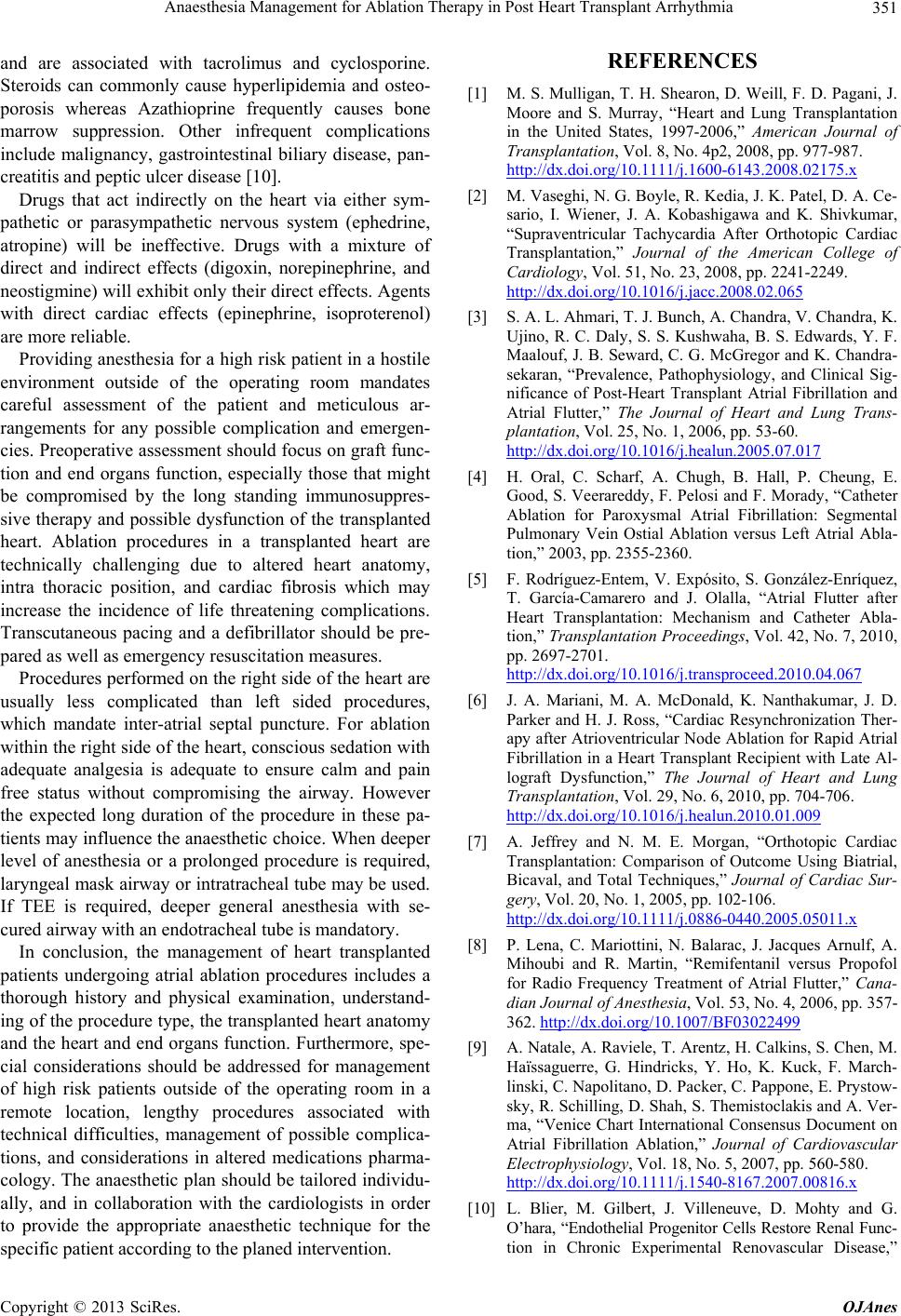
Anaesthesia Management for Ablation Therapy in Post Heart Transplant Arrhythmia 351
and are associated with tacrolimus and cyclosporine.
Steroids can commonly cause hyperlipidemia and osteo-
porosis whereas Azathioprine frequently causes bone
marrow suppression. Other infrequent complications
include malignancy, gastrointestinal biliary disease, pan-
creatitis and peptic ulcer disease [10].
Drugs that act indirectly on the heart via either sym-
pathetic or parasympathetic nervous system (ephedrine,
atropine) will be ineffective. Drugs with a mixture of
direct and indirect effects (digoxin, norepinephrine, and
neostigmine) will exhibit only their direct effects. Agents
with direct cardiac effects (epinephrine, isoproterenol)
are more reliable.
Providing anesthesia for a high risk patien t in a hostile
environment outside of the operating room mandates
careful assessment of the patient and meticulous ar-
rangements for any possible complication and emergen-
cies. Preoperative assessment should focus on graft func-
tion and end organs function, especially those that might
be compromised by the long standing immunosuppres-
sive therapy and possible dysfunction of the transplanted
heart. Ablation procedures in a transplanted heart are
technically challenging due to altered heart anatomy,
intra thoracic position, and cardiac fibrosis which may
increase the incidence of life threatening complications.
Transcutaneous pacing and a defibrillator should be pre-
pared as well as emergency resuscitation measures.
Procedures performed on the right side of the heart are
usually less complicated than left sided procedures,
which mandate inter-atrial septal puncture. For ablation
within the right side of the heart, conscious sedation with
adequate analgesia is adequate to ensure calm and pain
free status without compromising the airway. However
the expected long duration of the procedure in these pa-
tients may influence the anaesthetic choice. When deeper
level of anesthesia or a prolonged procedure is required,
laryngeal mask airway or intratracheal tube may be used.
If TEE is required, deeper general anesthesia with se-
cured airway with an endotracheal tube is mandatory.
In conclusion, the management of heart transplanted
patients undergoing atrial ablation procedures includes a
thorough history and physical examination, understand-
ing of the procedure type, the transplanted heart anatomy
and the heart and end organs function. Furthermore, spe-
cial considerations should be addressed for management
of high risk patients outside of the operating room in a
remote location, lengthy procedures associated with
technical difficulties, management of possible complica-
tions, and considerations in altered medications pharma-
cology. The anaesthetic plan shou ld be tailored individu-
ally, and in collaboration with the cardiologists in order
to provide the appropriate anaesthetic technique for the
specific patient according to the planed intervention.
REFERENCES
[1] M. S. Mulligan, T. H. Shea ron, D. Weill, F. D. Pagani, J.
Moore and S. Murray, “Heart and Lung Transplantation
in the United States, 1997-2006,” American Journal of
Transplantation, Vol. 8, No. 4p2, 2008, pp. 977-987.
http://dx.doi.org/10.1111/j.1600-6143.2008.02175.x
[2] M. Vaseghi, N. G. Boyle, R. Kedia, J. K. Patel, D. A. Ce-
sario, I. Wiener, J. A. Kobashigawa and K. Shivkumar,
“Supraventricular Tachycardia After Orthotopic Cardiac
Transplantation,” Journal of the American College of
Cardiology, Vol. 51, No. 23, 2008, pp. 2241-2249.
http://dx.doi.org/10.1016/j.jacc.2008.02.065
[3] S. A. L. Ahmari, T. J. Bunch, A. Chandra, V. Chandra, K.
Ujino, R. C. Daly, S. S. Kushwaha, B. S. Edwards, Y. F.
Maalouf, J. B. Seward, C. G. McGregor and K. Chandra-
sekaran, “Prevalence, Pathophysiology, and Clinical Sig-
nificance of Post-Heart Transplant Atrial Fibrillation and
Atrial Flutter,” The Journal of Heart and Lung Trans-
plantation, Vol. 25, No. 1, 2006, pp. 53-60.
http://dx.doi.org/10.1016/j.healun.2005.07.017
[4] H. Oral, C. Scharf, A. Chugh, B. Hall, P. Cheung, E.
Good, S. Veerareddy, F. Pelosi and F. Morady, “Catheter
Ablation for Paroxysmal Atrial Fibrillation: Segmental
Pulmonary Vein Ostial Ablation versus Left Atrial Abla-
tion,” 2003, pp. 2355-2360.
[5] F. Rodríguez-Entem, V. Expósito, S. González-Enríquez,
T. García-Camarero and J. Olalla, “Atrial Flutter after
Heart Transplantation: Mechanism and Catheter Abla-
tion,” Transplantation Proceedings, Vol. 42, No. 7, 2010,
pp. 2697-2701.
http://dx.doi.org/10.1016/j.transproceed.2010.04.067
[6] J. A. Mariani, M. A. McDonald, K. Nanthakumar, J. D.
Parker and H. J. Ross, “Cardiac Resynchronization Ther-
apy after Atrioventricular Node Ablation for Rapid Atrial
Fibrillation in a Heart Transplant Recipient with Late Al-
lograft Dysfunction,” The Journal of Heart and Lung
Transplantation, Vol. 29, No. 6, 2010, pp. 704-706.
http://dx.doi.org/10.1016/j.healun.2010.01.009
[7] A. Jeffrey and N. M. E. Morgan, “Orthotopic Cardiac
Transplantation: Comparison of Outcome Using Biatrial,
Bicaval, and Total Techniques,” Journal of Cardiac Sur-
gery, Vol. 20, No. 1, 2005, pp. 102-106.
http://dx.doi.org/10.1111/j.0886-0440.2005.05011.x
[8] P. Lena, C. Mariottini, N. Balarac, J. Jacques Arnulf, A.
Mihoubi and R. Martin, “Remifentanil versus Propofol
for Radio Frequency Treatment of Atrial Flutter,” Cana-
dian Journal of Anesthesia, Vol. 53, No. 4, 2006, pp. 357-
362. http://dx.doi.org/10.1007/BF03022499
[9] A. Natale, A. Raviele, T. Arentz, H. Calkins, S. Chen, M.
Haïssaguerre, G. Hindricks, Y. Ho, K. Kuck, F. March-
linski, C. Napolitano, D. Packer, C. Pappone, E. Prystow-
sky, R. Schilling, D. Shah, S. Themistoclakis and A. Ver-
ma, “Venice Chart International Consensus Document on
Atrial Fibrillation Ablation,” Journal of Cardiovascular
Electrophysiology, Vol. 18, No. 5, 2007, pp. 560-580.
http://dx.doi.org/10.1111/j.1540-8167.2007.00816.x
[10] L. Blier, M. Gilbert, J. Villeneuve, D. Mohty and G.
O’hara, “Endothelial Progenitor Cells Restore Renal Func-
tion in Chronic Experimental Renovascular Disease,”
Copyright © 2013 SciRes. OJAnes